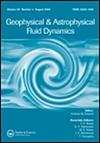射流在静稳定性过渡附近的动态稳定性
IF 1.1
4区 地球科学
Q3 ASTRONOMY & ASTROPHYSICS
Geophysical and Astrophysical Fluid Dynamics
Pub Date : 2020-08-05
DOI:10.1080/03091929.2020.1795150
引用次数: 0
摘要
在中纬度地区,地球大气的垂直剖面包含两个大致恒定的稳定层之间的急剧过渡区,称为对流层顶,并且在几乎相同的高度也显示出急流,急流核心可能高于或低于对流层顶,这取决于时间和位置。射流与对流层顶的这种接近预计会极大地影响射流的动态稳定性,这里用Bickley剖面模拟的射流和用tanh剖面模拟的对流层顶来处理。采用切比雪夫配置谱法对稳定性结果进行了数值计算。结果表明,当射流在对流层顶下方进一步移动时,它变得更加不稳定。相应的二维和三维非线性流动模拟证实了初始增长,并表明当射流在对流层顶以上时,配置更稳定,更容易产生强的单一不稳定模态。模拟结果表明,这种不稳定性将发展成孤立的波包络模式。相反,当射流在对流层顶以下时,射流更有可能形成一个广谱的运动。本文章由计算机程序翻译,如有差异,请以英文原文为准。
Dynamic stability of a jet near a transition in static stability
The vertical profile of the Earth's atmosphere in middle latitudes contains a sharp transition region between two roughly constant stability layers, termed the tropopause and also exhibits jet streams at nearly the same altitude, with the jet stream core possibly above or below the tropopause, depending on time and location. This proximity of the jet to the tropopause would be expected to greatly affect the dynamic stability of the jet, treated here with the jet modelled with the Bickley profile and the tropopause modelled as a smooth transition region with a tanh profile. Stability results are obtained numerically using a Chebyshev collocation spectral method. The results show that the jet becomes more unstable as it is moved further beneath the tropopause. Corresponding two- and three-dimensional nonlinear simulations of the flow confirm the initial growth, and indicate that when a jet is above the tropopause, the configuration is more stable and more likely to produce a strong single unstable mode. The simulations indicate that this instability will grow to form a solitary wave envelope pattern. Conversely, when a jet is below the tropopause, the jet is more likely to form a broad spectrum of motion.
求助全文
通过发布文献求助,成功后即可免费获取论文全文。
去求助
来源期刊

Geophysical and Astrophysical Fluid Dynamics
地学天文-地球化学与地球物理
CiteScore
3.10
自引率
0.00%
发文量
14
审稿时长
>12 weeks
期刊介绍:
Geophysical and Astrophysical Fluid Dynamics exists for the publication of original research papers and short communications, occasional survey articles and conference reports on the fluid mechanics of the earth and planets, including oceans, atmospheres and interiors, and the fluid mechanics of the sun, stars and other astrophysical objects.
In addition, their magnetohydrodynamic behaviours are investigated. Experimental, theoretical and numerical studies of rotating, stratified and convecting fluids of general interest to geophysicists and astrophysicists appear. Properly interpreted observational results are also published.
 求助内容:
求助内容: 应助结果提醒方式:
应助结果提醒方式:


